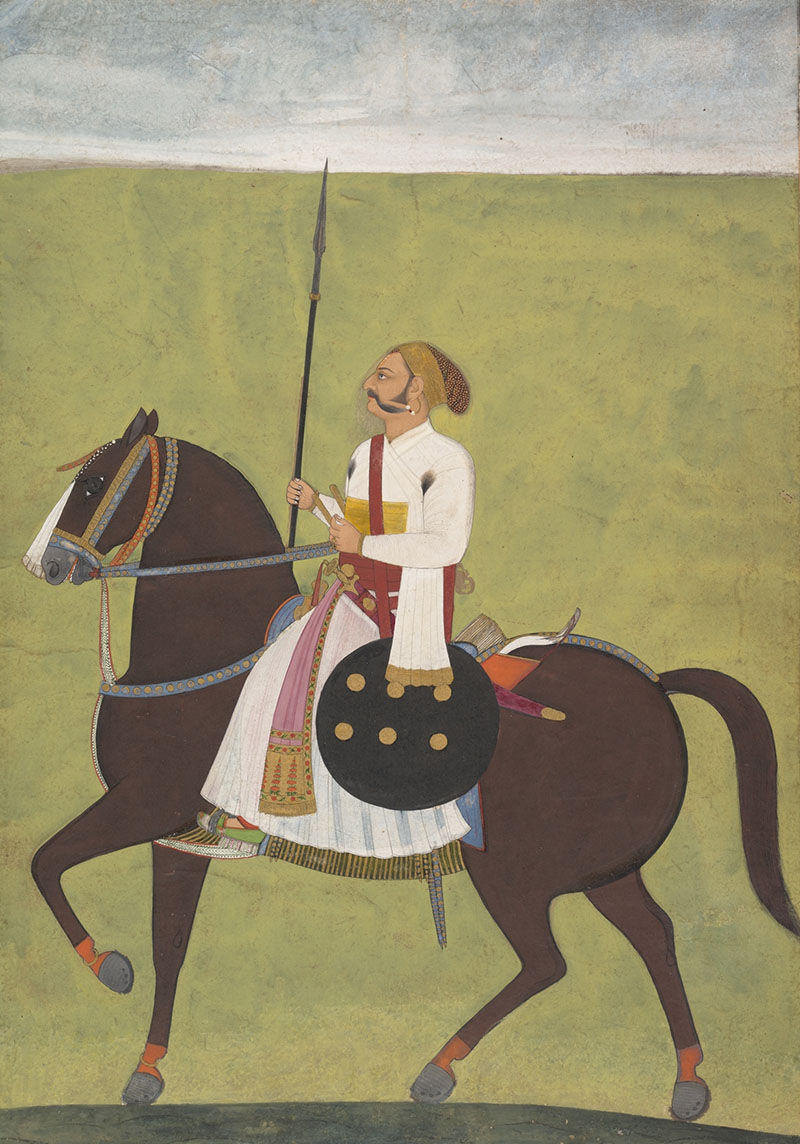The son of acclaimed artist Bhavanidas, Dalchand was a painter who worked in the Mughal imperial atelier and later at the Rajput courts of Marwar and Kishangarh. Along with his father, he is considered to be one of the prominent artists of the Kishangarh school of painting.
Scholars believe Dalchand may have trained as an artist in Lahore, before relocating to Delhi in 1707 to work at the Mughal court during the reign of Muhammad Shah (1719–1748 CE). He is likely to have moved to the court of Jodhpur in 1724, and two works from this period attributed to him are portraits of the then ruler of Marwar, Maharaja Abhai Singh. One of these works, titled Maharaja Abhai Singh Watching a Dance Performance (c. 1725), shares similarities in composition with a mid-eighteenth century painting of Muhammad Shah watching a dance performance. Another portrait from the same year – titled Maharaja Abhai Singh on Horseback – depicts the Marwari ruler on a horse, accompanied by members of his retinue.
Inscriptions on two paintings completed during his time in Jodhpur show that Dalchand signed his name as “Dilli ra chitara Dalchand,” which translates to “the Delhi artist, Dalchand,” further suggesting that he received his training at the Mughal atelier in Delhi. He is believed to have joined his father at the Kishangarh court in 1728.






![The façade of the Maneckji Seth Agiary, a Zoroastrian fire temple, is a standout example of the popularity of the Persian Revival Style in Western India in the 19th and 20th centuries. This style was often seen in the architectural patronage of the Parsis, who emerged as one of the most influential mercantile communities of British India. Popular motifs of this style, like the mythical lamasus (winged bulls with human heads) and the faravahar (a winged guardian spirit in Zoroastrianism), drew on the historical art and architecture of the Achaemenid and Sasanian empires from sites like Persepolis, Bisotun, Taq-e Bostan, Naqsh-e Rostam and Naqsh-e Rajab in Persia.
The Parsi community’s adoption of this style occurred largely due to their networks of global commerce and politics, allowing them to access and translate research of ancient Persia into visible symbols that underlined their association with antiquity, imperial power, and art.
نمای آتشکدهی زرتشتی مانِکجی سِت نمونهی بارزی از رواج سبک «احیای [معماری] ایرانی» در غرب هند طی سدههای نوزدهم و بیستم است. این سبک غالباً در بناهایی دیده میشد که پارسیان، از بانفوذترین جوامع بازرگان در هند بریتانیا، بانیشان بودند. نقشمایههای محبوب این سبک، مانند گاو بالدار اساطیری (لاماسو) و فَروَهَر (روح بالدار نگهبان در دین زرتشت)، برگرفته از هنر و معماری شاهنشاهی هخامنشی و ساسانی، در جاهایی چون تخت جمشید و بیستون و طاق بستان و نقش رستم و نقش رجب، بود.
اقتباس جامعهی پارسیان از این سبک بسیار مرهون روابط گستردهی تجاری و سیاسی آنها بود که دسترس به پژوهشها دربارهی ایران باستان و برگردانیدن آنها به نمادهای بصری را ممکن میکرد و بر پیوند پارسیان با دوران باستان و قدرت شاهنشاهی و هنر تأکید میکرد.](https://mapacademy.io/wp-content/plugins/instagram-feed/img/placeholder.png)
